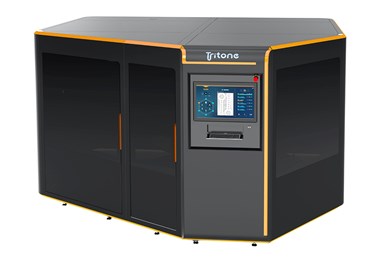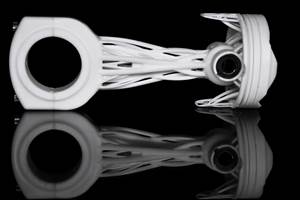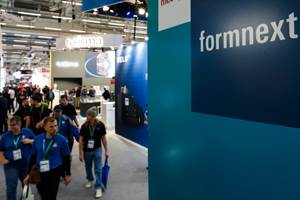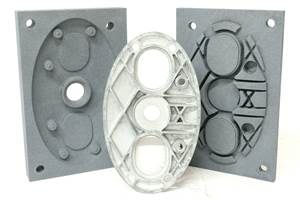MoldJet Technology Enables High-Throughput Metal, Ceramic Additive Manufacturing
Formnext 2023: Tritone Technologies’ additive manufacturing solutions enable industrial throughput of accurate parts with a range of metal and ceramic materials.
Tritone Technologies’ MoldJet, Dominant and Dim technologies for metal and ceramic additive manufacturing (AM) are designed to enable industrial throughput of accurate parts with a range of metal and ceramic materials, suitable for the automotive, aerospace, medical and consumer electronics industries. The technology works with a wide selection of high-performance materials, including copper, stainless steels, titanium, tool steels, high temperature alloys, and ceramic across diverse applications.
MoldJet is a powder-free AM technology that enables production of metal and ceramic parts at industrial scale and speed. It is designed for producing complex geometry parts, with high density and great mechanical properties. The technology enables a quick and easy changeover between a wide variety of metals and ceramics, with parts of different geometries and applications manufactured in the same batch. Operational benefits include a powder-free and hands-free process, labor-free technology, highly robust green parts, a safe industrial environment and more.
The technology features a simultaneous process that produces large quantities of parts per shift utilizing a variety of metal alloys. The system creates fine detail and smooth surface quality with high printing resolution and precision for enabling complex part geometries. Part sizes can range from 2-mm to more than 400-mm parts. An auto layer correction feature enables real-time verification and control of the quality of each layer. Materials are delivered through sealed cartridges — suitable for a clean industrial environment. Robust green parts enable easy transition to sinter without damaging part quality.
The Dominant system utilizes the MoldJet technology for industrial throughput with a simultaneous process that exceeds throughput of 1,600 cc/hr to produce large quantities of parts per shift. The build volume is 400 × 240 × 120 mm (L × W × H) over 6 trays. The machine footprint is 3,200 × 2,200 × 1,900 mm (L × W × H).
The Dim system also offers industrial throughput with simultaneous process with this system exceeding throughput of 220 cc/hr. It features a build volume of 220 × 120 × 90 mm (L × W × H) over 4 trays. The machine footprint is 2,150 × 1960 × 1800 mm (L × W × H).
- Read about Tritone’s collaboration with DSH Technologies to launch the Outsource Sintering Furnace-Access Program. Through the Furnace-Access program, Tritone customers will have immediate access to Elnik sintering furnaces and metallurgy expertise with no upfront capital investment or additional staffing required.
- Learn about APG utilizing Tritone’s MoldJet technology for metal parts production. APG delivers highly engineered powder metal, metal injection molding (MIM) and AM components, serving a diverse customer base with a range of high-performance applications.
Related Content
Casting With Complexity: How Casting Plus 3D Printing Combine the Strengths of Both
Aristo Cast is advancing a mode of part production in which casting makes the part, but 3D printing enables the geometry.
Read MoreXJet Produces First Entirely Ceramic Piston for Chaos Ultracar
Company says no other technology could achieve the accuracy and complexity required to create Spyros Panopoulos Automotive’s lightweight ceramic design.
Read MoreWhat We Found at Formnext 2023
New metal processes, new possibilities for existing processes, the next step for copper and more. Here is a summary drawing on all our reporting from November’s event.
Read MoreFoundry Lab: How Casting in a Day Will Improve the Design of Metal Parts (Includes Video)
The company’s digital casting process uses 3D printing, but the result is a cast part. By providing a casting faster than a foundry, the company says effective prototyping is now possible for cast parts, as well as bridge production.
Read MoreRead Next
Video: Intelligent Layering Metal 3D Printing at 3DEO
Contract manufacturer 3DEO delivers metal parts using Intelligent Layering, a binder jetting-like 3D printing process the company developed and operates internally. Here’s how it works.
Read MoreLooking to Secure the Supply Chain for Castings? Don't Overlook 3D Printed Sand Cores and Molds
Concerns about casting lead times and costs have many OEMs looking to 3D print parts directly in metal. But don’t overlook the advantages of 3D printed sand cores and molds applied for conventional metal casting, says Humtown leader.
Read MoreTo Improve Performance of Compression Molded Composites, Add 3D Printed Preforms
9T Labs' Additive Fusion Technology enables the manufacture of composite structures with as much or as little reinforcement as is necessary, using 3D printed continuous fiber preforms to add strength just where needed.
Read More










.png;maxWidth=300;quality=90)













